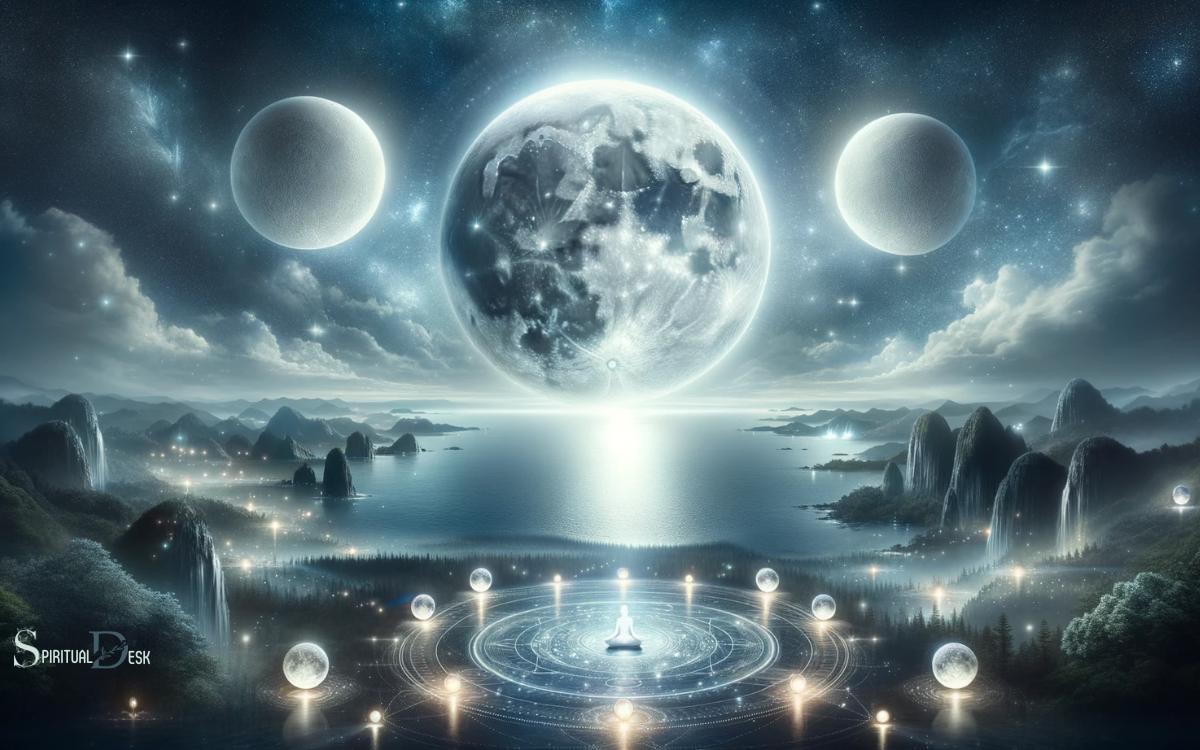What Is The Spiritual Meaning Of Moon? Intuition!
The spiritual meaning of the moon largely signifies intuition, subconsciousness, and feminine divine energy.
Moon often symbolizes a deep personal journey, inner wisdom, and the phases of human life. In spirituality, a full moon’s energy is seen as a potent time for banishing, healing, releasing, and manifesting intentions.
The moon is an important spiritual symbol and is often considered a beacon of intuition and inner wisdom.
Just as the moon cycles through phases, it’s believed to reflect the cyclical nature of human experiences and personal growth.
Moreover, the moon is also associated with feminine energy and divine essence, illuminating the darkness and guiding through unseen realms.
The spiritual significance of the moon is deeply interconnected with our personal and spiritual journey.
Its cyclical nature, the ebb and flow of light, and its serene presence in the night sky embodies our intuitive abilities, the cyclical nature of life, the nurturing feminine energy, and the guiding inner wisdom.
The moon, in its ethereal glow, teaches us the importance of phases, timing, and the power of quiet introspection.

Key Takeaway
8 Aspects: Spiritual Meaning of the Moon
| Phase of the Moon | Spiritual Meaning |
|---|---|
| New Moon | Beginnings, fresh start, renewal, set intentions |
| Waxing Crescent | Manifestation, growth, creativity |
| First Quarter | Challenges, decisions, action |
| Waxing Gibbous | Refinement, analyze, prepare |
| Full Moon | Fullness, harvest, celebration, realization |
| Waning Gibbous | Introspection, gratitude, sharing |
| Last Quarter | Release, letting go, forgiveness |
| Waning Crescent | Surrender, rest, recuperation |
Origins of Lunar Symbolism
The origins of lunar symbolism can be traced back to ancient civilizations across the world, where the moon was revered as a powerful and mysterious celestial body. In various cultures, the moon was associated with deities, fertility, and the rhythm of time.
The Mesopotamians, for instance, linked the phases of the moon to the changing seasons and agricultural fertility.
In ancient Egypt, the moon was connected to the god Khonsu, representing the passage of time and the growth of crops.
Similarly, in Hindu mythology, the moon is personified as the deity Chandra, symbolizing immortality and eternity.
The moon�s influence on the natural world and its recurring cycles captivated early societies, leading to the development of rich symbolism and spiritual significance associated with this enigmatic celestial body.
This deep-rooted symbolism laid the foundation for the moon�s prominent role in mythology and folklore.
Moon in Mythology and Folklore
In various ancient cultures across the world, the moon held significant importance as it was associated with deities, fertility, and the rhythm of time, leading to its prominent role in mythology and folklore.
- In Greek mythology, the moon was linked to the goddess Artemis, representing the feminine and the natural cycles of life.
- In Hindu mythology, the moon, known as Chandra, is a symbol of rejuvenation and immortality.
- Similarly, in Norse mythology, the moon was associated with the god Mani, who guided the moon�s chariot across the night sky.
These mythological connections have enriched the moon with symbolism, shaping cultural beliefs and practices for centuries.
Understanding the moon�s mythological significance provides insight into its spiritual and symbolic meanings.
This understanding sets the stage for exploring the diverse lunar symbolism in different cultures.
Lunar Symbolism in Different Cultures
Lunar symbolism in different cultures reflects a rich tapestry of mythological connections and spiritual significance associated with the moon.
Throughout history, the moon has been revered and personified in various ways, shaping cultural beliefs and practices.
Here is a glimpse of how the moon is symbolized in different cultures:
| Culture | Lunar Symbolism |
|---|---|
| Chinese | Yin and yang, representing balance and harmony |
| Native American | Symbol of feminine energy and connection to the earth |
| Hindu | Depiction of time, cyclical nature, and immortality |
These examples illustrate the diverse interpretations of the moon�s symbolism across different societies, emphasizing its universal importance.
Understanding these varied perspectives provides insight into the profound influence of the moon on spiritual practices and beliefs.
Moon�s Influence on Spiritual Practices
Incorporating the moon�s influence on spiritual practices reveals a deep connection to the divine and a profound reverence for celestial rhythms across cultures.
This influence is manifested in various spiritual practices, including:
- Rituals: Many spiritual traditions have specific rituals and ceremonies that are aligned with the lunar cycle. These may include full moon or new moon ceremonies, where practitioners gather to harness the moon�s energy for spiritual growth and manifestation.
- Meditation: The phases of the moon often serve as focal points for meditation practices. Meditating during different lunar phases is believed to offer unique energetic qualities, allowing individuals to align their spiritual intentions with the corresponding lunar energy.
Understanding the moon�s influence on spiritual practices provides insight into the interconnectedness of the natural world and the spiritual realm, offering a profound sense of harmony and attunement.
Esoteric Significance of Lunar Phases
The esoteric significance of lunar phases encompasses the profound connection between the moon�s cycles and human emotions, influencing our inner world in mysterious ways.
Understanding how manifestation aligns with the different lunar phases offers a unique perspective on harnessing cosmic energy for personal growth and spiritual development.
Exploring the spiritual growth cycles tied to the moon�s phases can provide valuable insights into the cyclical nature of life and the opportunities for transformation that each phase presents.
Moon and Emotions
The interplay between the moon�s phases and human emotions is a significant aspect of its spiritual meaning. The esoteric significance of lunar phases in relation to emotions is a captivating subject.
Consider the following points to understand the connection between the moon and emotions:
- Lunar Phases: The waxing and waning of the moon symbolize the ebb and flow of emotions in human life.
- New Moon: This represents new beginnings and a time for introspection, often associated with feelings of renewal and hope.
- Full Moon: Signifies culmination and fulfillment, often linked to heightened emotions and amplified energy.
Understanding the esoteric significance of lunar phases can provide insight into the cyclical nature of emotions and the interconnectedness of the human experience with the celestial realm.
Manifestation During Phases
During each phase of the moon, specific energies and intentions are believed to manifest in accordance with the esoteric significance of lunar phases.
The moon�s phases, including the new moon, waxing moon, full moon, and waning moon, are thought to influence the manifestation of desires and intentions.
Here is a breakdown of the esoteric significance of each lunar phase:
| Lunar Phase | Esoteric Significance |
|---|---|
| New Moon | Setting intentions, new beginnings |
| Waxing Moon | Attraction, growth, manifestation |
| Full Moon | Harvesting, culmination, abundance |
| Waning Moon | Release, letting go, cleansing |
Understanding the esoteric significance of each lunar phase allows individuals to align their intentions and manifestations with the natural energies of the moon, enhancing their spiritual practices and personal growth.
Spiritual Growth Cycles
As the moon progresses through its phases, it initiates spiritual growth cycles that align with the esoteric significance of each lunar phase.
This cosmic phenomenon offers individuals an opportunity for introspection, growth, and transformation.
The lunar phases hold esoteric significance, with each phase symbolizing unique spiritual themes:
New Moon:
- A time for setting intentions and planting new seeds of growth.
Full Moon:
- A period for manifestation and culmination of spiritual energies.
Understanding and aligning with these lunar phases can guide individuals through their spiritual journey, helping them harness the energy of each phase for personal growth and spiritual evolution.
By recognizing and attuning to the spiritual significance of the moon�s phases, individuals can harmonize their inner cycles with the celestial rhythms, fostering spiritual development and enlightenment.
Moon as a Divine Feminine Symbol
The moon has long been associated with the divine feminine, symbolizing the nurturing and intuitive aspects of the feminine energy.
Its connection to the lunar cycle is seen as a reflection of the phases of a woman�s life, linking it to the cycles of birth, growth, and renewal.
This symbolism emphasizes the moon�s influence on intuition, emotions, and the interconnectedness of all living things.
Feminine Energy Representation
Representing feminine energy, the moon serves as a divine symbol in various spiritual and religious traditions.
This symbolism is deeply rooted in the concept of the moon as a nurturing and intuitive force, embodying the characteristics often associated with the feminine.
In many belief systems, the moon is revered as a goddess, mother, or queen, symbolizing fertility, creativity, and wisdom.
The moon�s cyclical nature is often linked to the phases of a woman�s life, representing birth, growth, and renewal.
The following are key aspects of the moon�s representation of feminine energy:
- Nurturing: The moon�s gentle and calming presence is often likened to the nurturing and comforting qualities associated with motherhood.
- Reflective: Symbolizing introspection and inner wisdom, the moon encourages self-reflection and emotional understanding.
Lunar Cycle Connection
An integral aspect of the moon�s representation of feminine energy lies in its connection to the lunar cycle, serving as a divine symbol of the cyclical nature of feminine power and influence.
The lunar cycle, with its phases of waxing and waning, mirrors the ebb and flow of feminine energy, representing the ever-changing yet continuous nature of women�s strength and wisdom.
This cyclical pattern reflects the rhythms of a woman�s life, her connection to nature, and her ability to create and nurture life.
The moon�s association with the divine feminine symbolizes the nurturing, intuitive, and emotionally expressive aspects of women.
Understanding the moon�s connection to the lunar cycle provides insight into the deep spiritual significance of its influence on the feminine energy and the interconnectedness of women with the natural world.
Intuitive and Emotional
The moon embodies the intuitive and emotional aspects of the divine feminine, reflecting a deep connection to women�s inner wisdom and emotional expression.
Intuitive Connection
- The moon symbolizes intuition, inner knowing, and the ability to tap into unseen realms, encouraging women to trust their instincts and embrace their intuitive nature.
- It serves as a reminder to honor the power of receptivity and to listen to the whispers of the heart and soul.
Emotional Expression
- The moon�s phases mirror the ever-changing tides of emotions, offering a symbol of the cyclical nature of women�s feelings and the importance of embracing and expressing emotions.
- It encourages women to connect with their emotional depths, nurturing a sense of empathy and understanding for themselves and others.
Harnessing Lunar Energy for Spiritual Growth
Harnessing lunar energy can significantly contribute to an individual�s spiritual growth and well-being.
The moon�s energy can be harnessed through various practices such as meditation, intention setting, and ritual work.
During the different phases of the moon, specific energies can be utilized for different purposes. For instance, the new moon is a time for new beginnings and setting intentions, while the full moon is a time for releasing and manifestation.
By aligning oneself with these lunar energies, individuals can deepen their spiritual connection, gain insight into their emotional patterns, and enhance their intuitive abilities.
Regularly connecting with the moon�s energy can bring about a sense of balance, inner peace, and spiritual alignment.
It is important to approach lunar energy with reverence and an open heart to fully benefit from its spiritual potential.
Conclusion
The spiritual significance of the moon spans across various cultures and traditions, symbolizing the divine feminine, spiritual growth, and the cyclical nature of life.
From ancient mythology to modern esoteric practices, the moon�s influence on spiritual beliefs and practices has remained an enduring and universal symbol of introspection and transformation.
Its enigmatic presence continues to inspire awe and wonder, reminding us of the timeless wisdom and guidance that can be found in the celestial realms.
FAQ About What Is The Spiritual Meaning Of Moon?
What Is The Spiritual Meaning Of The Moon?
The moon represents intuition, emotions, and feminine energy, providing guidance and fostering spiritual growth.
How Does The Moon Affect Spirituality?
The moon’s influence on tides and emotions allows for a deeper understanding of oneself and enhances spiritual connections.
Can The Moon’s Phases Impact Spiritual Practices?
Absolutely, as the changing phases of the moon offer opportunities for setting intentions, releasing negative energy, and embracing new beginnings.
What Role Does The Full Moon Play In Spirituality?
The full moon symbolizes completion, illumination, and heightened energy, making it a powerful time for rituals, manifestation, and self-reflection.
How Can One Harness The Moon’S Spiritual Energy?
Engage in moon rituals, meditation, and visualization, aligning intentions with the moon’s energy to enhance spiritual experiences and growth.






